Large bowel resection - series
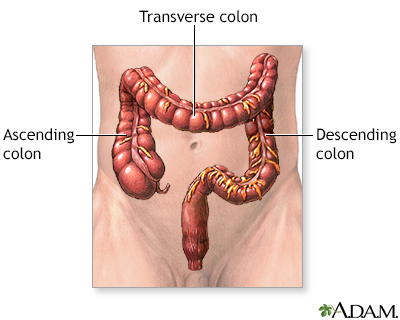
Normal anatomy
The large bowel [large intestine or the colon] is part of the digestive system. It runs from the small intestine to the rectum. It is made up of three portions; the ascending, transverse and descending colon. The ascending colon is sometimes referred to as the right colon; the descending colon is sometimes referred to as the left, or sigmoid colon.
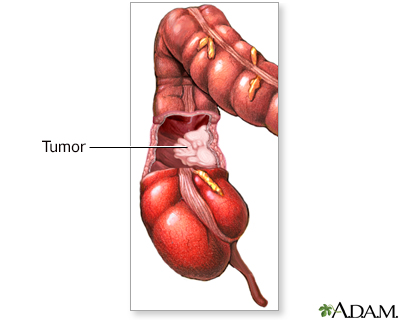
Indications
Bowel resection may be indicated for:
- Blockage of the intestine (intestinal obstruction) due to scar tissue or tumors
- Bleeding, due to diverticulosis or arteriovenous malformations
- Injuries
- Cancer
- Precancerous polyps
- Familial polyposis
- Infection, due to diverticulitis
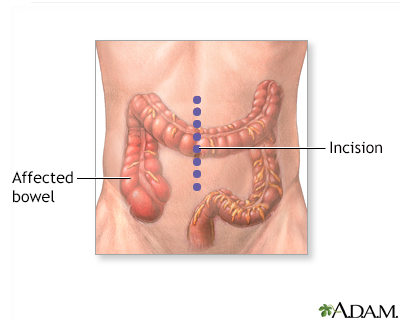
Incision
The patient is deep asleep and pain-free (general anesthesia). A lower midline incision is made in the abdomen. Sometimes, the surgeon will use a lateral lower transverse incision instead.

Procedure, part 1
The diseased part of the large intestine (colon) is removed. The two healthy ends are then sewn or stapled back together and the incision is closed. A stapling procedure is shown here.
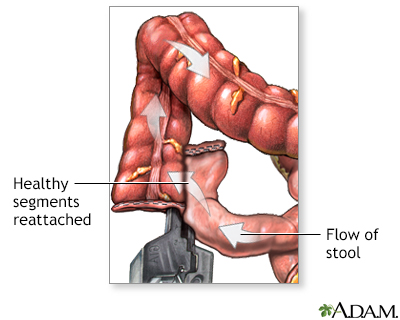
Procedure, part 2
If it is necessary to spare the intestine from its normal digestive work while it heals, a temporary opening of the intestine onto the abdomen (colostomy) may be done. A temporary colostomy will be closed and repaired later. If a large portion of the bowel is removed, the colostomy may be permanent. The large intestine (colon) absorbs most of the fluid from foods. When the colon is bypassed by a colostomy in the right colon, the colostomy output is generally liquid stool (feces). If the colon is bypassed in the left colon, the colostomy output is generally more solid stool. The constant or frequent drainage of liquid stool can cause the skin around the colostomy to become inflamed. Careful skin care and a well-fitting colostomy bag can reduce this irritation.
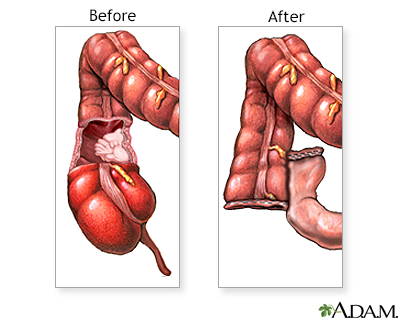
Aftercare
Most patients will stay in the hospital for 5 to 7 days. Complete recovery from surgery may take 2 months. During the first few days after surgery, eating is restricted.
Related Information
Colorectal cancerLarge bowel resection
BACK TO TOP
Review Date: 4/18/2023
Reviewed By: John Roberts, MD, Professor of Internal Medicine (Medical Oncology), Yale Cancer Center, New Haven, CT. He is board certified in Internal Medicine, Medical Oncology, Pediatrics, Hospice and Palliative Medicine. Review provided by VeriMed Healthcare Network. Also reviewed by David C. Dugdale, MD, Medical Director, Brenda Conaway, Editorial Director, and the A.D.A.M. Editorial team.

Health Content Provider
06/01/2025
|
A.D.A.M., Inc. is accredited by URAC, for Health Content Provider (www.urac.org). URAC's accreditation program is an independent audit to verify that A.D.A.M. follows rigorous standards of quality and accountability. A.D.A.M. is among the first to achieve this important distinction for online health information and services. Learn more about A.D.A.M.'s editorial policy, editorial process and privacy policy. A.D.A.M. is also a founding member of Hi-Ethics. This site complied with the HONcode standard for trustworthy health information from 1995 to 2022, after which HON (Health On the Net, a not-for-profit organization that promoted transparent and reliable health information online) was discontinued. |
The information provided herein should not be used during any medical emergency or for the diagnosis or treatment of any medical condition. A licensed medical professional should be consulted for diagnosis and treatment of any and all medical conditions. Links to other sites are provided for information only -- they do not constitute endorsements of those other sites. © 1997- 2024 A.D.A.M., a business unit of Ebix, Inc. Any duplication or distribution of the information contained herein is strictly prohibited.
